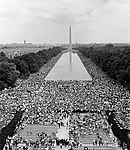Korean War Veterans Memorial
1995 sculpturesArtworks in the collection of the National Park ServiceKorean War memorials and cemeteriesMilitary monuments and memorials in the United StatesMonuments and memorials on the National Register of Historic Places in Washington, D.C. ... and 6 more
National Mall and Memorial ParksNational Memorials of the United StatesOutdoor sculptures in Washington, D.C.Southwest (Washington, D.C.)Steel sculptures in Washington, D.C.United States in the Korean War

The Korean War Veterans Memorial is located in Washington, D.C.'s West Potomac Park, southeast of the Lincoln Memorial and just south of the Reflecting Pool on the National Mall. It memorializes those who served in the Korean War.
Excerpt from the Wikipedia article Korean War Veterans Memorial (License: CC BY-SA 3.0, Authors, Images).Korean War Veterans Memorial
Daniel French Drive SW, Washington
Geographical coordinates (GPS) Address Nearby Places Show on map
Geographical coordinates (GPS)
| Latitude | Longitude |
|---|---|
| N 38.887777777778 ° | E -77.047222222222 ° |
Address
Korean War Veterans Memorial
Daniel French Drive SW
20418 Washington
District of Columbia, United States
Open on Google Maps










